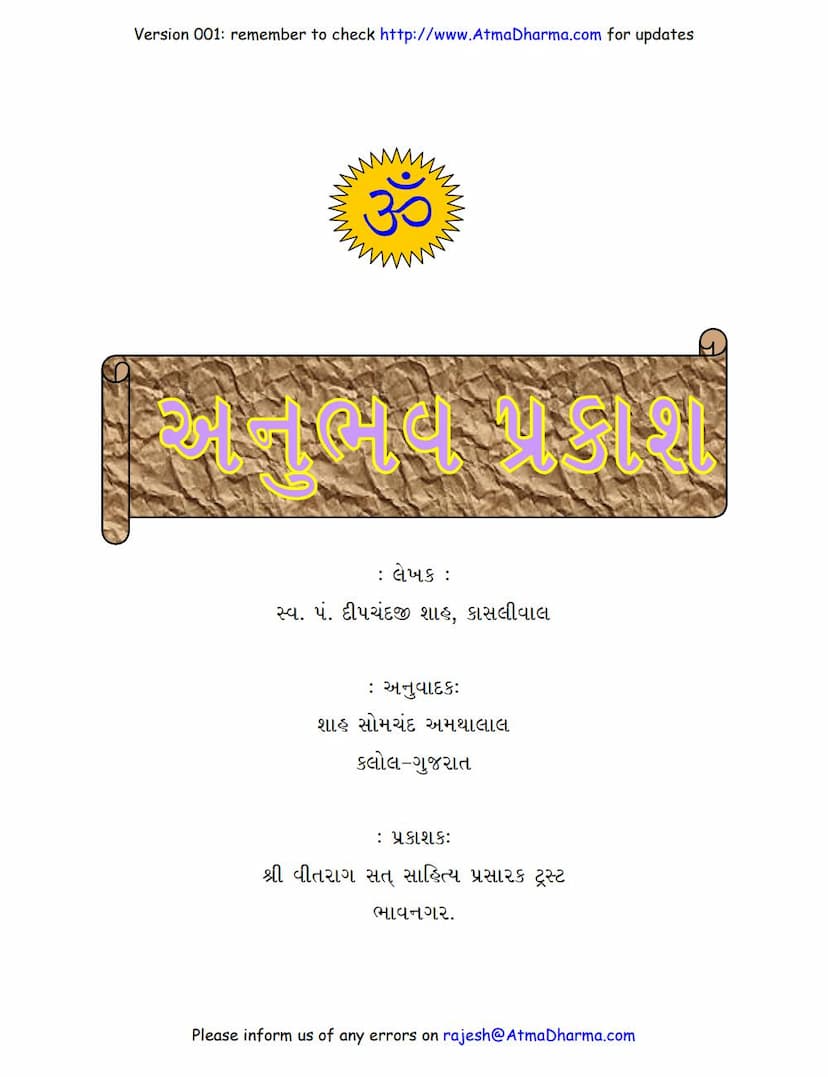Anubhav Prakash
Added to library: September 1, 2025

Summary
Here's a comprehensive summary of the Jain text "Anubhav Prakash" by Dipchand Shah Kasliwal, based on the provided pages:
Book Title: Anubhav Prakash (The Light of Experience) Author: Late Pt. Deepchandji Shah Kasliwal (Jaipuri) Translator: Shah Somchand Amthalal (Kalol, Gujarat) Publisher: Shri Vitrag Sat Sahitya Prasarak Trust, Bhavnagar
Overall Theme:
"Anubhav Prakash" is a profound and concise prose work focused on the direct, experiential realization of the soul's true nature. It guides the reader towards self-discovery, emphasizing the importance of inner experience over mere intellectual understanding. The text delves into the essence of the soul, the means to attain self-realization, the distinction between the self and non-self, the bliss of inner experience, and the path to liberation. It draws heavily from the core principles of Jainism, particularly the emphasis on right faith, knowledge, and conduct (Samyak Darshan, Gyan, Charitra) as the path to Moksha (liberation).
Key Concepts and Teachings:
- The Nature of the Soul (Atma): The soul is described as the true self, pure, sentient, blissful, infinite in knowledge and perception, and eternally unchanging in its essence, despite its association with karmic impurities. It is the ultimate reality, distinct from the non-soul (Jad) substances.
- The Path to Self-Realization (Anubhav): The book emphasizes that true liberation comes not from external rituals or intellectual pursuits alone, but from direct, inner experience of the soul. This experience is attained through deep contemplation, introspection, and the practice of right faith, knowledge, and conduct.
- Distinction Between Self and Non-Self (Saadhya-Saadhak Bhed): A crucial aspect of the teachings is the clear discernment between the eternal, unchanging soul (the ultimate goal or saadhya) and the transient, material world and its associated phenomena, including the body, senses, mind, and even the subtle karmic forces (the means or saadhak in a broader sense). Mistaking the non-soul for the self is the root cause of suffering.
- The Bliss of Inner Experience (Nij-Swaroop Sukha): The text repeatedly points to the inherent bliss and peace that resides within the soul. This bliss is not derived from external objects or pleasures but is an intrinsic quality of the soul itself, accessible through self-awareness.
- Overcoming Ignorance and Attachment: The primary obstacle to self-realization is identified as ignorance (ajñāna) and the resulting attachments (mamata, raag, dvesh) to non-soul entities. The book provides guidance on how to dissolve these attachments and the ignorance that perpetuates them.
- The Role of Right Faith and Knowledge: The text underscores that right faith (Samyak Shraddha) in the true nature of the soul and right knowledge (Samyak Gyan) of the self and non-self are foundational for experiencing the soul.
- Spiritual Practices: While the emphasis is on direct experience, the text alludes to practices like meditation (dhyan), contemplation (vichar), and unwavering focus (upayoga) on the soul as means to attain this experience.
- The Soul's Unchanging Nature: Despite being veiled by karma and experiencing the cycle of birth and death, the soul's inherent nature remains pure and untouched. This inherent purity is the basis for the possibility of liberation.
- The Importance of Guidance: The text implicitly highlights the role of a Guru or enlightened being in guiding the aspirant towards self-realization, as exemplified by the references to Sri Gurudev Shri Kanji Swami.
- Rejection of False Notions: The book challenges various misconceptions, such as identifying with the body, mistaking external pleasures for true happiness, and clinging to the illusory nature of the external world.
- The Power of Inner Realization: The ultimate message is that true liberation and eternal bliss are not external pursuits but the inherent realization of one's own true nature, the soul.
Structure and Content:
The book is structured into various chapters or sections, as indicated by the table of contents and the chapter headings within the text. These sections cover topics such as:
- Mangalacharan (Invocation): A traditional invocation seeking blessings.
- Atma ka Swaroop (Nature of the Soul): Describing the soul's true essence.
- Anubhav Varnan (Description of Experience): Detailing the nature of inner realization.
- Samaadhi Varnan (Description of Samadhi/Concentration): Explaining the state of focused awareness on the soul.
- Devadhikar (Discussion on Deities/Tirthankaras): Discussing the role and nature of liberated beings (Arhats and Siddhas) as guides and examples.
- Jñānādhikār (Discussion on Knowledge): Explaining the nature and significance of true knowledge.
- Śeyādhikār (Discussion on the Knowable/Objects of Knowledge): Analyzing the categories of knowable substances.
- Nijadharmādhikār (Discussion on Self-Nature): Elaborating on the soul's inherent qualities.
- Mishradharmādhikār (Discussion on Mixed Virtues): Addressing the transitional stages where true nature is partially realized.
- Nishchayvastuswaroop (The True Nature of Reality): A deep dive into the ultimate essence of the self.
The text is rich with analogies and illustrations from everyday life and scriptural references to convey complex philosophical concepts in a relatable manner. It consistently guides the reader inward, urging them to look beyond the superficial and realize the eternal, blissful reality within.
Significance:
"Anubhav Prakash" serves as a practical guide for spiritual seekers on the Jain path. It moves beyond mere dogma and encourages a direct, lived experience of the spiritual truth. Its concise yet profound explanations make it an accessible text for those aspiring to achieve self-realization and liberation. The devotional verses dedicated to Gurudev Shri Kanji Swami further highlight its lineage and the importance of the Guru's grace in spiritual progress.